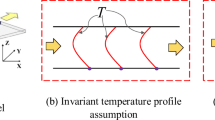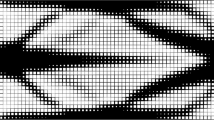Abstract
The level set topology optimization method for 2D and 3D cooling channels, considering convective heat transfer for high Reynolds number flows, is presented in this paper. The Darcy potential flow, which is a low-fidelity linear flow model, is used to simulate the flow using the finite element method. The resulting velocity field is used in a convection-diffusion model to simulate the heat transfer using the finite element method. A linear combination of the pressure drop and the average temperature is considered as the objective function, which is minimized subject to a volume constraint and a maximum length scale constraint. The results show that the pressure drop and the average temperature are conflicting criteria, and the trade-off between the two criteria is investigated. We perform a verification study by comparing the Darcy flow field of the obtained optimum designs with that of a high fidelity turbulence model. The verification study shows that there exists a reasonable agreement between the Darcy and the turbulent flow field for narrow channels. Therefore, by restricting the design space to narrow channels, we optimize the cooling performance and sufficiently capture the turbulent flow physics using the low-fidelity Darcy flow model. Finally, we show an example in 3D where we optimize the cooling channel topology that conforms to the surface of a sphere.





















Similar content being viewed by others
References
Arora JS (2004) Introduction to optimum design. Elsevier, Amsterdam
Asmussen J, Alexandersen J, Sigmund O, Andreasen CS (2019) A “poor man’s” approach to topology optimization of natural convection problems. Struct Multidiscip Optim 59(4):1105–1124
Borrvall T, Petersson J (2003) Topology optimization of fluids in stokes flow. Int J Numer Methods Fluids 41(1):77–107
Dilgen CB, Dilgen SB, Fuhrman DR, Sigmund O, Lazarov BS (2018a) Topology optimization of turbulent flows. Comput Methods Appl Mech Eng 331:363–393
Dilgen SB, Dilgen CB, Fuhrman DR, Sigmund O, Lazarov BS (2018b) Density based topology optimization of turbulent flow heat transfer systems. Struct Multidiscip Optim 57(5):1905–1918
Dimla D, Camilotto M, Miani F (2005) Design and optimisation of conformal cooling channels in injection moulding tools. J Mater Process Technol 164:1294–1300
Dunning PD, Kim HA, Mullineux G (2011) Investigation and improvement of sensitivity computation using the area-fraction weighted fixed grid fem and structural optimization. Finite Elem Anal Des 47(8):933–941
Dunning PD, Kim HA (2015) Introducing the sequential linear programming level-set method for topology optimization. Struct Multidiscip Optim 51(3):631–643
Gersborg-Hansen A, Sigmund O, Haber RB (2005) Topology optimization of channel flow problems. Struct Multidiscip Optim 30(3):181–192
Guest JK, Prévost JH (2006) Topology optimization of creeping fluid flows using a darcy–stokes finite element. Int J Numer Methods Eng 66(3):461–484
Hu P, He B, Ying L (2016) Numerical investigation on cooling performance of hot stamping tool with various channel designs. Appl Therm Eng 96:338–351
Jahan S, Wu T, Shin Y, Tovar A, El-Mounayri H (2019) Thermo-fluid topology optimization and experimental study of conformal cooling channels for 3d printed plastic injection molds. Procedia Manuf 34:631–639
Koga AA, Lopes ECC, Nova HFV, De Lima CR, Silva ECN (2013) Development of heat sink device by using topology optimization. Int J Heat Mass Transfer 64:759–772
Kontoleontos E, Papoutsis-Kiachagias E, Zymaris A, Papadimitriou D, Giannakoglou K (2013) Adjoint-based constrained topology optimization for viscous flows, including heat transfer. Eng Optim 45(8):941–961
Pollini N, Sigmund O, Andreasen CS, Alexandersen J (2020) A “poor man’s” approach for high-resolution three-dimensional topology design for natural convection problems. Adv Eng Softw 140:102736
Qiao H (2006) A systematic computer-aided approach to cooling system optimal design in plastic injection molding. Int J Mech Sci 48(4):430–439
Sethian JA (1999) Level set methods and fast marching methods: evolving interfaces in computational geometry, fluid mechanics, computer vision, and materials science, vol 3. Cambridge University Press
Sethian JA, Vladimirsky A (2000) Fast methods for the eikonal and related hamilton–jacobi equations on unstructured meshes. Proc Natl Acad Sci 97(11):5699–5703
Tan MHY, Najafi AR, Pety SJ, White SR, Geubelle PH (2016) Gradient-based design of actively-cooled microvascular composite panels. Int J Heat Mass Transfer 103:594–606
Wang G, Zhao G, Li H, Guan Y (2011) Research on optimization design of the heating/cooling channels for rapid heat cycle molding based on response surface methodology and constrained particle swarm optimization. Expert Syst Appl 38(6):6705–6719
Wu J, Aage N, Westermann R, Sigmund O (2017) Infill optimization for additive manufacturing—approaching bone-like porous structures. IEEE Trans Vis Comput Graph 24(2):1127–1140
Wu T, Tovar A (2018) Design for additive manufacturing of conformal cooling channels using thermal-fluid topology optimization and application in injection molds. In: ASME 2018 International design engineering technical conferences and computers and information in engineering conference, pp v02BT03a007–v02BT03a007. American Society of Mechanical Engineers
Yaji K, Yamada T, Kubo S, Izui K, Nishiwaki S (2015) A topology optimization method for a coupled thermal–fluid problem using level set boundary expressions. Int J Heat Mass Transfer 81:878–888
Yoon GH (2010) Topological design of heat dissipating structure with forced convective heat transfer. J Mech Sci Technol 24(6):1225–1233
Yoon GH (2016) Topology optimization for turbulent flow with spalart–allmaras model. Comput Methods Appl Mech Eng 303:288–311
Zhao X, Zhou M, Sigmund O, Andreasen CS (2018) A “poor man’s approach” to topology optimization of cooling channels based on a darcy flow model. Int J Heat Mass Transfer 116:1108–1123
Zhao X, Zhou M, Liu Y, Ding M, Hu P, Zhu P (2019) Topology optimization of channel cooling structures considering thermohmechanical behavior. Struct Multidiscip Optim 59(2):613–632
Acknowledgments
We would like to thank the anonymous reviewers and the handling editor, Prof. Ole Sigmund, for their insightful comments that greatly improved the manuscript.
Funding
The authors acknowledge the support from DARPA (Award number HR0011-16-2-0032) and NASA Transformational Tools and Technologies (TTT) project (grant number 80NSSC18M0153).
Author information
Authors and Affiliations
Corresponding author
Ethics declarations
Conflict of interest
The authors declare that they have no conflict of interest.
Replication of results
The supplementary material provided the Ansys Fluent case and data files for the baseline design and the optimized 2D designs obtained for w = 0.8.
Additional information
Responsible Editor: Ole Sigmund
Publisher’s note
Springer Nature remains neutral with regard to jurisdictional claims in published maps and institutional affiliations.
Electronic supplementary material
Rights and permissions
About this article
Cite this article
Kambampati, S., Kim, H.A. Level set topology optimization of cooling channels using the Darcy flow model. Struct Multidisc Optim 61, 1345–1361 (2020). https://doi.org/10.1007/s00158-019-02482-6
Received:
Revised:
Accepted:
Published:
Issue Date:
DOI: https://doi.org/10.1007/s00158-019-02482-6




